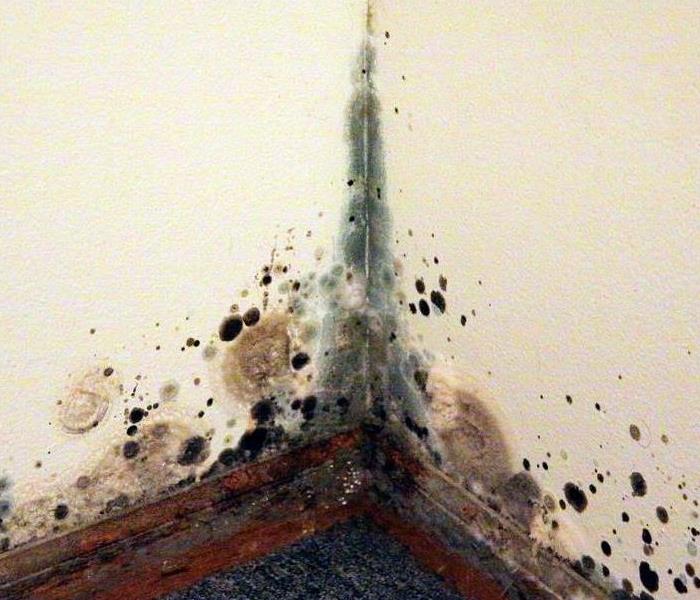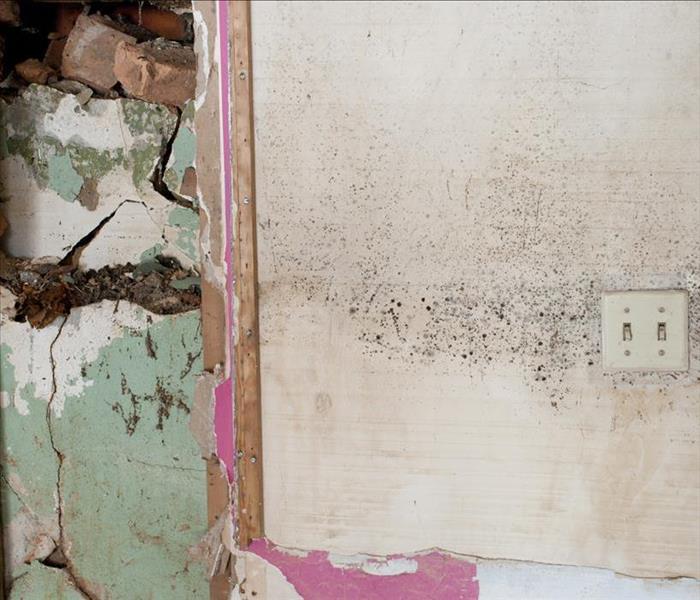Archived Mold Remediation Blog Posts
How to Remove Mold From Your Home
1/20/2020 (Permalink)
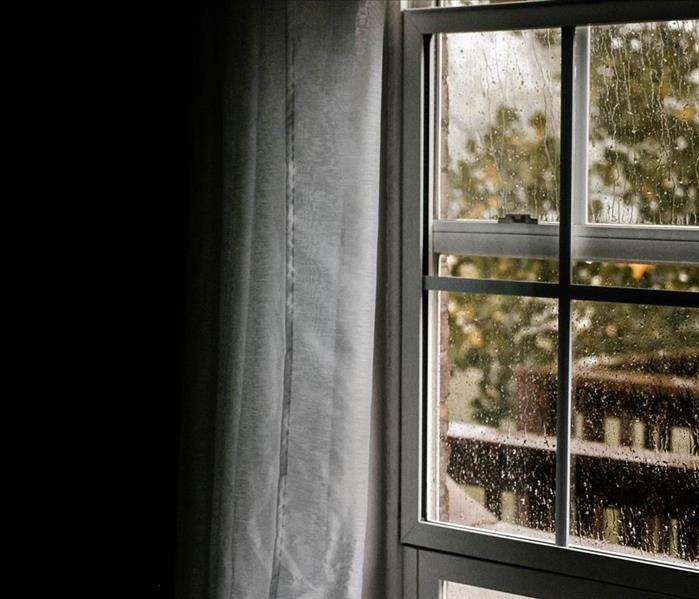 Mold comes from water damage and water damage can come from anywhere, including as simple as a rainy day.
Mold comes from water damage and water damage can come from anywhere, including as simple as a rainy day.
Knowing the facts about mold is helpful in household information. However, many of the details and truths about mold can get lost in the process. This is the case, especially when it comes to the fact that we can search for any process online through all of the blogs that exist. Several unaccredited, sourceless websites can post procedures without actual facts about things like, for example, how to remove mold from your home. For instance, some people believe bleach can kill mold. That’s not true. While it can temporarily remove the mold, the spores from the initial mold will grow back within a couple of weeks of spraying the bleach.
Similarly, people may consider merely painting over the mold. The truth is that you cannot only paint over top of the mold. Even if it could be, that would pose a long term threat to the safety of the home because the mold would still impact the air quality. The truth is that mold can only be removed appropriately with equipment by professionals. There isn’t an article online that can teach the ways of mold removal in the safest possible way. Most of the life hacks centered around mold removal do not acknowledge that mold spores can exist unseen even after we remove the mold. Mold spores can wait for the proper environment and begin the fruition process as soon as those environmental needs have been met. Therefore, only professionals can create a genuinely safe removal process of mold.
If you find mold in your home, call your local SERVPRO of North Fulton at (770) 992-2777. SERVPRO of North Fulton is an affordable option for mold remediation. They’ll assess the damage and walk you through the process required in order to make your home “Like it never even happened.”
Professional Mold Testing: Why Everyone Should Have Their Homes Inspected For Mold
3/4/2019 (Permalink)
As a homeowner, you know there is a lot that can go wrong without regular upkeep and maintenance. Lawns can become unruly, dust will collect, and HVAC systems can harbor nasty buildups of dirt and debris. One thing that often gets overlooked on the to-do list is to get your house screened for mold by a professional. Mold lives in every home, whether in large or small amounts. However, if not properly managed and remediated, it will continue to grow, eventually leading to potential structural damage. Not only can mold wreak havoc on the surfaces and framework in your house, but it can also pose serious health risks to you and your family. Learn the types of mold you might find in your home, signs for when it’s time for professional mold testing, reasons why professional mold testing is important, and steps involved in the home mold inspection process.
Kinds of Mold Found in Homes
There are thousands of types of mold growing in the world, and a number of them can be found right in your own home. The three most common types you might find growing in your house during a home mold inspection include Stachybotrys, Aspergillus, and Cladosporium.
Stachybotrys: Stachybotrys, also known as the infamous black mold or toxic mold, is an incredibly common household mold. It is typically dark green or black in color and has a slimy texture. Black mold is a toxigenic mold, meaning it can cause certain symptoms in the human body if inhaled or ingested. Black mold flourishes in moist areas with high humidity, such as kitchens, bathrooms, basements, and crawl spaces.
Aspergillus: Aspergillus is a type of allergenic mold that can be found primarily in-home air conditioning systems, as well as growing on foods that are decomposing. As an allergenic mold, it can cause symptoms such as lung infections and asthma attacks if inhaled. Aspergillus can be a variety of different colors and can grow in thick layers on walls.
Cladosporium: Rounding out the list of the most common household molds is Cladosporium, an allergenic mold that makes its home in materials such as carpets, fabrics, and upholsteries. You might even spot inside cupboards. As an allergenic, it can produce a variety of symptoms on the skin, or in the eyes, nose, and throat.
When to Test for Mold
If you think you might have mold growing, how do you know when it’s time to have a professional mold testing? The following signs can indicate that it’s time for a professional home mold inspection:
- Visible signs of mold: if you spot mold, you should have a home mold inspection. Even if it looks to be a small amount, mold will continue to grow in the environment. If you spot mold, do not attempt to touch or disturb it. A professional company will have the proper equipment to handle the situation safely.
- If you smell a musty odor: many types of mold emit a tell-tale musty, moldy odor. If you notice an unpleasant smell without a clear source in your bathroom, basement, or crawl space, have your home tested to locate the mold and take remediation steps.
- Water damage: flooded basements, burst pipes, and leaky roofs all leave your home vulnerable to mold growth. If you’ve recently had a water damage event in your house, it’s time for a professional mold testing. Following water damage, mold can begin to grow almost immediately, so having the test done right away can prevent large overgrowths.
- The onset of health issues: If you or someone in your home starts to experience symptoms such as coughing, wheezing, itchy eyes, sore throat, sneezing, or rash that are not tied to a known health condition, have a home mold inspection as various types can cause symptoms mentioned.
- If you spot unusual stains: unusual stains on your house or on furniture could mean mold. If you spot new stains have a professional mold testing done to address the issue.
Impact of Mold on Health
Making the decision to have a professional mold testing is important, as exposure can spell serious consequences, especially for particularly vulnerable populations like infants, the elderly, or individuals with existing respiratory conditions. Exposure to mold can result in serious skin rashes and hives, as well as lung infections, difficulty breathing, and asthma. Some exposure will require treatments such as antibiotics, antihistamines, decongestants, or nasal sprays.
Professional Mold Testing: What to Expect
The mold testing process involves a few specific steps to make a determination about the extent of your mold problem, and what should be done next to remediate. The test will begin first with a visual inspection. The inspector will walk throughout each room paying close attention to hidden spaces. They will also inspect your HVAC system, a well-known spot for mold growth. In addition to visually inspecting the interior of your house, they will also take a look at the outside of your house to note any potential risks for water entering your home.
Following the visual mold inspection, during the mold testing, the inspector will make a diagnosis. You will be notified of any sources of moisture that might be causing mold growth, areas of particular concern where larger, potentially harmful overgrowths were spotted, as well as any sources of humidity noted.
Once a diagnosis has been made, the inspector will conduct a fungal sampling as part of the mold inspection. Samples will be taken of not only the colonies of mold found growing, but also of the air in your home to determine whether or not the mold you have is allergenic and a health risk. Once the results of the fungal sampling are complete, the inspector will have a better idea of the level of contamination you’re dealing with.
The final step in the professional mold testing process is a written report. In the written report, the inspector will thoroughly layout for you their findings and recommendations for remediation.
Mold Remediation Tips: How To Control A Mold Outbreak
2/18/2019 (Permalink)
As a homeowner, you know that caring for a house comes with a great deal of responsibility in order to maintain value and upkeep over time. Unfortunately, in homes large or small, there are lots of things that can go wrong. Among one of the most common challenges homeowners face is the presence of mold. Finding mold in your house is a cause for worry, and should be addressed immediately. When left untreated, mold outbreaks can cause damage and even pose a health risk to occupants of the home. To best equip yourself in the fight against mold, learn what it is, its cause, mold remediation definition, and mold remediation tips.
What is Mold?
Molds are actually a very natural part of the environment and are found in many places in the outside world. In the proper environment, molds are effective in breaking down dead matter, such as decaying trees and dead leaves. What exactly is mold? They are a type of fungus, and they are comprised of microscopic spores that can’t be seen by the naked eye. There are thousands of different types of molds, and they can appear in a variety of colors. Most often, they will take on a green, blue, or black appearance. The nutrients from which the mold feasts are what determines its colors. Additionally, the age of a mold colony and surface on which it grows influences the color.
When inhaled, mold can have harmful effects on the respiratory system, causing symptoms such as coughing, wheezing, sneezing, itchy eyes, sore throat, and more. Contact with mold can also result in skin rashes and hives that require treatment from a medical professional. Those with existing conditions such as asthma should pay particular attention not to enter mold-prone areas.
Types of Household Mold
While there are a number of different types of mold that can be found growing in the damp areas of a home, a few of the most common are:
Black Mold: One of the most common types of mold found in a household is the infamous black mold. Black mold is classified as a toxigenic mold, that can elicit allergic reactions in humans when inhaled. In most cases, black mold will be black or dark green in color and will feature a slimy texture. It is attracted to surfaces including cardboard, woods, and wicker.
Alternaria: Alternaria is the most common type of allergenic mold, that can be found in areas of the home including leaky sinks, showers, and bathtubs. Alternaria is usually brown or dark green in color and has a velvety texture. Following water damage in a home, it is likely that Alternaria will appear.
Chaetomium: In addition to black mold and Alternaria, Chaetomium is another type of mold often found growing in water damaged homes. This type of mold has a cotton-like texture and ranges in color from brown to grey to white. Chaetomium is a common inhabitant of basements and leaky roofs. It can be identified by its musty odor.
What Causes Mold Outbreaks?
Humidity: Humidity a common cause of mold outbreaks, as mold needs moisture to grow. Following particularly humid weather, it is not uncommon to start to see mold growing in your house. Those that live in particularly humid areas, such as individuals with homes on the coast, are likely to experience recurring issues with mold. Humidity can also be created from humidifier machines and drying clothes indoors on clotheslines.
Poor Ventilation: A poorly ventilated room means moisture can start to pool and puddle. This, in turn, feeds mold growth. Spaces such as kitchens and vacuums, where high amounts of steam are produced, are especially susceptible to mold growth when ventilation is poor.
Flooding: Mold growth is also common following the flooding of a home. Basements, in particular, are at risk for flooding, whether due to cracks in the foundation, burst pipes or backed up sewer. Where there is standing water for a period of time, mold will follow. Making it more difficult to control the growth of mold is the fact that it can take days or even weeks for your home to fully dry.
Mold Remediation Tips
Mold remediation is defined as the removal, cleaning, and sanitizing of areas and surfaces that have been contaminated by mold. While it is impossible to remove all traces of mold, through mold remediation, you or a professional can restore mold levels to normal, natural levels.
If you’ve found mold growing in your house, do not despair. Use the following mold remediation tips to control a mold outbreak.
Contact a specialist. While you may be tempted to tackle a mold problem on your own, the safest option is to contact a specialist equipped to handle the mold remediation process safely and efficiently. They will conduct a full examination of the extent of mold growth, and develop a plan of action to remove harmful overgrowths.
Area containment. Once the problem areas have been identified, the specialist will contain the areas to prevent the travel of mold spores into other areas of the house. During this step, the specialist will also take dehumidifying measures to remove as much moisture from the space as possible.
Removal of contaminants. The specialist will now begin the process of removing mold, using various treatment products. Once done, they will safely dispose of the mold. The specialist will help to identify sources of moisture that might have caused the mold growth to begin with and offer recommendations for repairs.
Final testing. After the mold remediation process is complete, the specialist will conduct a final test of the space to ensure normal mold levels have been restored.
Following these mold remediation tips will help you quickly address mold issues, and prevent future outbreaks. Black mold removal and removal of other common household molds is a delicate process, but one that is necessary for the safety and well-being of your family. Contact a mold specialist today to discuss black mold removal, how to protect your house from water damage, or other questions you might have.
The Challenges of HVAC Mold Damage in Alpharetta
3/21/2018 (Permalink)
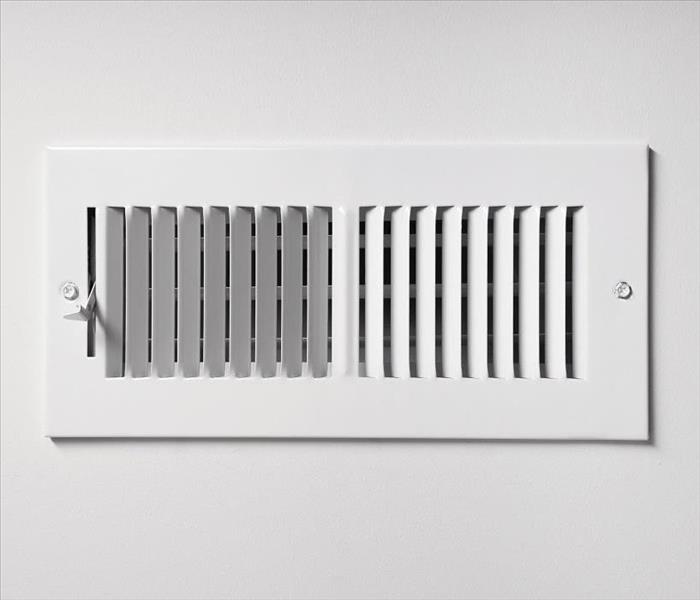 When mold forms in your HVAC system it is important to contact a professional mold remediation specialist like SERVPRO.
When mold forms in your HVAC system it is important to contact a professional mold remediation specialist like SERVPRO.
SERVPRO is Highly Trained in Mold Damage Remediation
Mold damage in an Alpharetta home's HVAC system can be tough to remove, requiring specialized training and knowledge in both restorative processes and proper HVAC care. SERVPRO is one of only a handful of companies possessing the expertise to handle both at the same time, but even for our most experienced technicians, mold in heating, ventilation, and air conditioning systems is no easy obstacle to overcome. Here are a few things that can complicate restoration procedures even with ideal tools, training, and circumstances.
Water Leaks
All varieties of mold damage in Alpharetta homes require water to be sustained, and while some species can subsist off of unusually humid conditions, most infestations accompany a water leak of some kind. Finding these leaks can be difficult, as both water lines in your home and HVAC systems run through unoccupied, dark, and out-of-sight areas of your home. SERVPRO representatives carry advanced thermohygrometer devices to spot patches of water behind walls and in unusual locations, allowing us to figure out the source of the mold's growth and put a stop to it. Only once we stop the flow of water can we begin to conduct restorative procedures.
Tight Spaces
Depending on the size, layout, and age of your home, your HVAC system may be very difficult to access and navigate. However, we prepare for this eventuality by training our technicians to handle all prevalent types of ventilation systems and should be able to take out colonies growing even in the farthest reaches of your home.
Spread-Out Spores
Many cases of mold damage in HVAC systems become much more substantial problems over time as air circulation allows spores to spread around not only the ventilation system but also throughout the entire home. No matter where you find a colony growing in your home, your first step should be to turn off any HVAC functions running at the time to prevent further spreading. While we cannot reverse any existing spread, our preventative measures and quarantines help to prevent additional problems from appearing throughout the home.
SERVPRO of North Fulton County is always available to take on a mold remediation project in your home. Call us as soon as you identify a problem at (770) 992-2777.
Click here for more information regarding Alpharetta.
Removing Mold Damage From Your Alpharetta Home Protects Your Indoor Air Quality
1/9/2018 (Permalink)
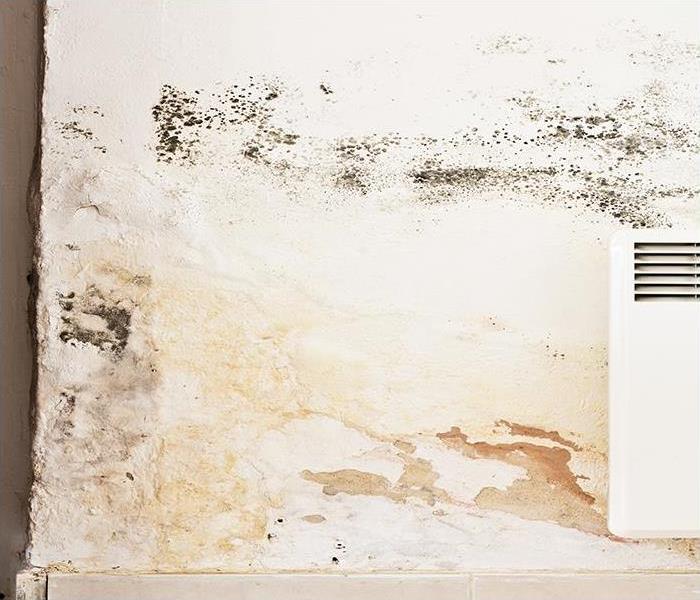 While mold and its spores exist almost everywhere, the presence of an excessive number of these can affect your home's air.
While mold and its spores exist almost everywhere, the presence of an excessive number of these can affect your home's air.
Removing Mold Damage From Your Home
While mold and its spores exist almost everywhere, the presence of an excessive number of these can affect your Alpharetta home's air. While mold causes damage to materials and belongings, it can also decrease the quality of the air that your family breathes.
Residents in Alpharetta often find mold damage affects their home in visible ways. However, the microbial count in the air should always remain low. When mold reproduces, it uses airborne spores to accomplish the task of spreading to another area for colonization. While these spores remain suspended, people breathe them in, which can cause health effects.
Removing the mold growing inside your home, including inside crawl spaces and other non-living areas, can protect your home and your family's health. SERVPRO's technicians hold certificates from the IICRC in Applied Microbial Remediation (AMRT). Prepared to not only locate unknown locations of mold growth but also to remediate microbial populations until they reach normal levels, we use the latest in technological advances and developments to help protect your home from mold growth.
Normal levels of microbial activity rarely pose problems, and no one can provide the total elimination of mold or other tiny microorganisms. This is partly because microbes continuously enter into your home. Using their favored mode of transport, air currents, we do eliminate the bulk of them by creating negative pressure in areas suffering from mold growth. Along with containment set up, we use air scrubbers to forcefully pull the air, and any particles suspended in it, out of your home.
Using negative pressure significantly reduces the number of spores able to infiltrate uncontaminated areas of your home. This is crucial for protecting your home during the removal of contaminated materials. As we work in removing anything with mold damage, the mold releases spores into the air. We wear personal protective equipment so we can safely work in such situations. We also wear this equipment during cleaning of non-porous materials, and during the application of antimicrobial agents.
SERVPRO of North Fulton County removes mold damage, prevents future mold colonization, and cleans the air during remediation services. Protecting your home is a crucial part of protecting your family's health. Call us, 24/7, at (770) 992-2777 for the latest in technological advances and equipment that can make any restoration work fast and effective.
Click here for more about the city of Alpharetta.
Prevent Mold Damage To Your Alpharetta Home Dishwasher
11/8/2017 (Permalink)
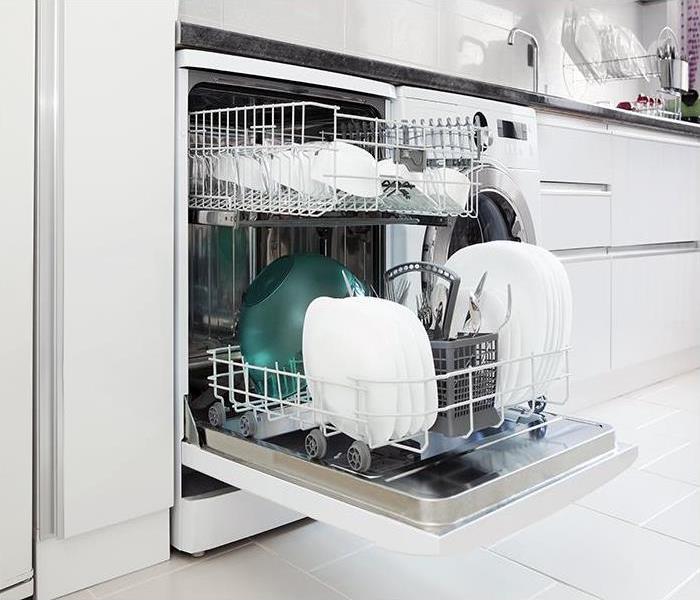 Thorough cleaning prevents mold growth and protects your dishwasher.
Thorough cleaning prevents mold growth and protects your dishwasher.
Prevent Mold Damage
Did you know that your dishwasher is susceptible to mold damage? People usually associate fungal growth with damp basements, bathrooms or laundry rooms, but in fact, the fungus can thrive anywhere there is moisture and a food source. As you can imagine, a dishwasher provides both water and nourishment. Food particles in the machine make it possible for mold and mildew to grow – and no one wants mold inside the dishwasher of their Alpharetta home!
SERVPRO knows that the thought of mold damage inside your Alpharetta dishwasher is not pleasant. Thankfully, dishwasher mold is not inevitable. Thorough cleaning prevents mold growth and protects your dishwasher. Here are some easy tips to help you.
Regularly cleanse areas of the machine where food particles collect. That includes the dish racks and silverware holders, the base and inside of the door, and of course the plastic filter at the bottom where bits of gunk accumulate.
Encourage drying by leaving the door open for a while after the end of a cycle. If your washer has a heat-dry setting, use it regularly. Using the hot dryer might cost a little more in electricity, but it saves you money in home mold remediation!
Clean seals once a week with a mild cleanser. You can make a useful cleaning agent by mixing a mild solution of white vinegar and water in a spray bottle. Spray the seals with the mixture and then wipe thoroughly with kitchen towel.
Deep clean your dishwasher once a month. Remove all racks and wash them thoroughly. Take advantage of the empty machine to wipe down all interior surfaces. Replace the racks, add a bowl of vinegar to the top rack, and run the machine on its hottest cycle. You can also sprinkle baking soda on the floor of the appliance before starting the cycle, for an even better clean.
The key to reducing mold growth is spotting signs of fungus. If you spot mold colonies in your kitchen or anywhere else in your home, call SERVPRO at once. Our professional mold remediators clean away visible mold and take steps to discourage regrowth.
For help with fungal growth in Alpharetta, Birmingham, Johns Creek, Crabapple and surrounding areas, contact SERVPRO of North Fulton County at (770) 992-2777 today.
Interested in learning more about the city of Alpharetta click here.
Carpet Mold Damage Remediation in Alpharetta
9/20/2017 (Permalink)
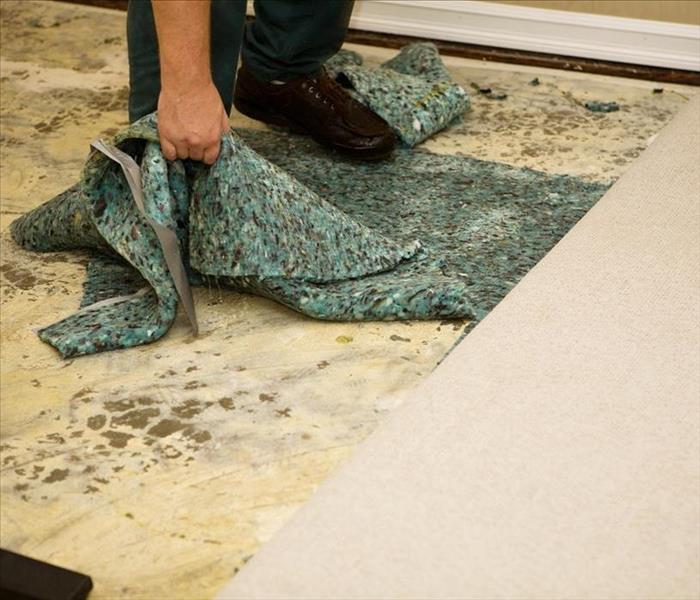 If you notice discolored patches in your carpet or a musty smell in your home, call SERVPRO to remediate the mold damage.
If you notice discolored patches in your carpet or a musty smell in your home, call SERVPRO to remediate the mold damage.
Hidden Mold in Your Carpet
No one in Alpharetta wants mold in their home. It is unsightly and can cause health effects. Just because the mold is not visible does not exactly mean that it is not there. In fact, mold prefers dark and moist environments, and the only time you can see it growing on the surface is in cases of severe contamination. Mold growth on the carpet is particularly aggressive and more often than not requires replacing the whole thing as well as the padding underneath.
If you suspect the presence of mold on your carpet, you need to contact a professional mold cleanup company immediately. As a locally-based and operated water damage remediation company, SERVPRO is strategically positioned to respond quickly to your emergency in Alpharetta. Our IICRC-approved technicians are available 24/7, delivering swift and efficient restoration services to the community and its environs.
Mold thrives under four conditions: oxygen, an organic source of food, moisture, and a surface on which to grow. Damp rugs and carpeting meet these requirements perfectly. The dust, dirt, pet dander, and microbes that settle in your carpet offer sufficient organic material on which the mold can feed. All you need is a little water to initiate mold growth.
If you act fast (typically within the first 48 hours), SERVPRO may be able to salvage the carpet. Using water extraction and dehumidification equipment, our technicians can remove the moisture and dry the fabric completely to counter the mold damage. Once the carpet is dry, we clean it thoroughly using a high-efficiency particulate air (HEPA) vacuum to get rid of the developed bacteria and mold spores.
If you notice a musty odor around the carpet area, it is a definite sign of mold growth and, possibly, mold damage. This smell might not be immediately noticeable if you spend a lot of time indoors, but take note if your guests comment on a moldy odor in your home as it may be a direct indication of mold. In severe cases, the mold may cause discolored patches on the carpet. These patches can be black, white, green, and a wide range of other colors.
When mold attacks your carpet, you have a short time before it causes irreversible damage. As soon as it happens, contact SERVPRO of North Fulton County to come in and counter the mold damage. We are available 24/7 at (770) 992-2777.
Click here to learn more about Alpharetta, Georgia.
Remediating Mold Damage in Alpharetta
6/27/2017 (Permalink)
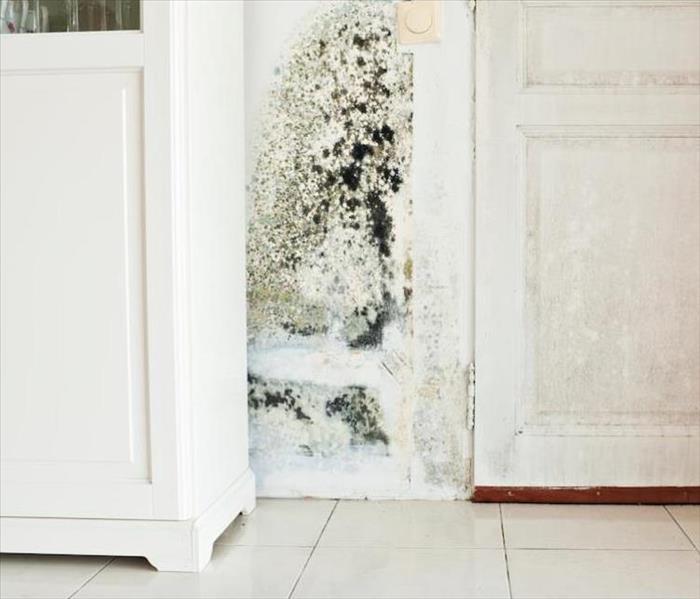 Let us investigate the moldy smell in your home. Call SERVPRO at the first sign of mold to root out the cause.
Let us investigate the moldy smell in your home. Call SERVPRO at the first sign of mold to root out the cause.
SERVPRO's Thorough Investigation Discovers the Cause of the Mold Infestation in Your Home
Mold is the disaster that sneaks in when no one is looking. After a fire or flood, a tiny number of spores can go unnoticed to expand, grow, and spread through a home in just a few weeks. Most people first notice mold by the telltale musty odor, but since not all mold gives off an odor, it is not a reliable indicator.
To ensure we take care of any mold damage in Alpharetta homes, SERVPRO uses the guidelines developed by the EPA as a framework for our work processes. We clean and dry moldy materials, discard moldy items that cannot be cleaned and dry non-moldy items within 48 hours.
Our first step is to find the source and extent of the growth. Our inspectors examine laundry rooms, basements, crawlspaces, and behind walls. They use air content meters to determine the percentage of contamination in each area of the home. Both examinations help us decide on the best cleaning methods.
If the contamination is limited to one area, we isolate it from the rest of the structure. Technicians establish containment by sealing off the HVAC vents and covering all entrances and other openings with thick, plastic sheeting. Now, we can clean the structure and personal property without spreading mold spores to the rest of the home.
We start by wiping down all surfaces. Technicians use a variety of cloths and sponges to dry wipe, removing most of the spores. If the growth is very thick in some spots, we use a vacuum that contains a HEPA filter. This filter is designed to remove and capture mold spores and works very efficiently on a dry or wet mold.
If the mold is wet or very damp, we use a cleaning agent to help separate the mold from the surface and remove it. Once removed, we wait for the surface to dry then wipe it down with a dry sponge or cloth to make certain we remove loose spores that may have settled from the air.
If the property is mold-free or if we cannot restore it, we remove it from the contaminated area. We dispose of the contaminated property according to state and federal regulations. Technicians place the mold-free items in a room where they can dry on their own, or we can set up air movers and fans to speed up the process. If there is not a mold-free room in the home, we will take it to our facility or other off-site storage to dry.
Restoring a home after a mold infestation can be a frustrating experience for owners and residents. SERVPRO of North Fulton County is here to help and walk you through every action and step along the way. If you have found mold or wish to schedule an inspection, call us at (770) 992-2777 today.
For more information regarding Alpharetta, click here
Check These Three Places For Hidden Mold Damage In Your Alpharetta Home
5/16/2017 (Permalink)
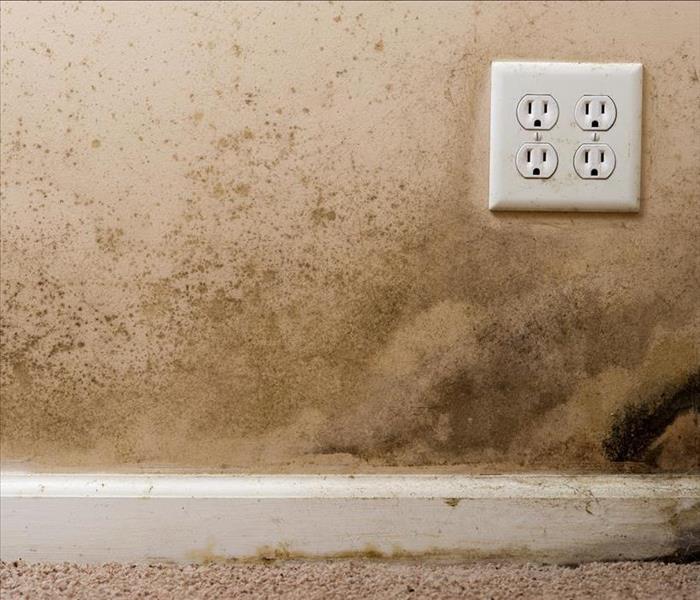 Remediation of Mold Damage in Alpharreta Carpets and Homes by SERVPRO
Remediation of Mold Damage in Alpharreta Carpets and Homes by SERVPRO
SERVPRO Tips For Mold Prevention
Mold is the enemy of every homeowner. Mold looks unsightly, smells bad, and can cause damage to your soft furnishings, carpets, clothes, and even your appliances or the structure of your home itself. Often the first sign of mold is a glimpse of discoloration on a wall or ceiling, or maybe noticing that telltale moldy smell in a bathroom or laundry room.
However, spores can grow in hidden places, too. You can reduce the risk of the fungus growing unnoticed and causing mold damage to your Alpharetta home by being proactive about looking for evidence of mold. SERVPRO recommends you check the following places for hidden contamination.
Chimneys
Chimneys are cold and can easily get damp from rain or even snow. Brickwork provides plenty of hidden crevices for spores to grow in. Make sure your chimney flashing is in good condition and replace it if need be. An annual visit from a chimney sweep is a good idea, too.
Kitchen Appliances
Most kitchen appliances get washed after every use, but there are still some hidden areas you must check regularly. Take a look at refrigerator drip trays, the door and seal of front-loading washing machines, and refrigerator and freezer seals. You can deal with mild cases using a weak bleach solution followed by a quick wipe with white vinegar.
Carpets and Carpet Pads
Carpets and carpet pads provide an environment where mold can propagate unnoticed, especially if a carpet gets wet. If your floor coverings get wet, call us at once. Our skilled teams come with free standing and truck mounted pumps and extraction tools to remove water and lessen the risk of fungus growing under your carpet or pad.
SERVPRO recommends putting in a call to us at the first sign of mold in your home. Our IICRC-certified technicians come prepared to set up containment to protect the rest of your home before getting to work on thoroughly cleaning the affected area. We use powerful HEPA vacuums to vacuum loose spores from surfaces, along with a combination of sanding, wire brush scrubbing, dusting, and wiping with a detergent solution to ensure each surface is properly cleaned of mold. We also use negative air machines when needed, to vent contaminated air outside your home.
When mold cleaning is complete, our trained experts bring in dehumidifiers and air movers to dry the affected room, carpet, or area back to its normal level of dryness and discourage further growth.
If you suspect mold growth in your home, give SERVPRO of North Fulton County a call at (770) 992-2777 today.
Alpharetta Mold Damage Needs Remediation
4/20/2017 (Permalink)
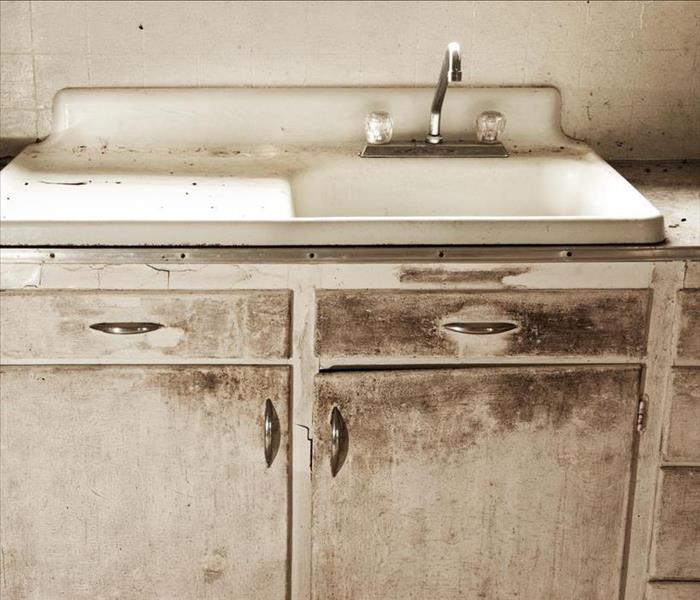 Alpharetta Mold Remediation Starts with a Call to SERVPRO
Alpharetta Mold Remediation Starts with a Call to SERVPRO
Rely on SERVPRO for Mold Cleanup in Your Alpharetta Home
Most fire and water damage are easy to see and straightforward to clean. An untrained individual can remove burned siding or waterlogged sheetrock, although we do not recommend this. What is much harder to find, clean, and remove is mold.
To stop and remediate the effects of mold damage in Alpharetta SERVPRO uses the IICRC (Institute of Inspection, Cleaning and Restoration Certification) Mold Remediation Standard. This is a five-step process that protects occupants and workers, cleans and removes mold, then eliminates the environmental factors that led to the initial infestation.
First, we reduce exposure. Homes with extensive mold growth can cause a limited number of health effects once the growth is disturbed by cleaning and removal procedures. Technicians isolate the affected areas from casual foot traffic by occupants in untouched areas and use the latest in industry-standard equipment to protect themselves.
Second, we document every action. Our remediation team records the initial inspection to include mold growth size, which rooms, hallways or work areas where it was found, and air content test results of mold spore and moisture levels. These are baselines we use to make sure surfaces are cleaned, and air quality has returned to normal after technicians complete their work.
Third, we control contamination at the source. After the area is isolated, we keep it from spreading as the cleaning procedures get underway. One of our best practices uses negative air machines at the point of drywall and other demolition. These devices draw out dust and particulates from the air; when combined with a HEPA filter, they pull out mold even down to the size of a single spore.
Fourth, we remove the contamination. The particles removed by negative air machines are typically blown outside of your home, but can also be captured and removed to another location. Any debris that has settled onto a surface is then wiped down using a dry cloth. Thicker amounts of contamination require a cleaning agent and a wet cloth. In some cases, a vacuum with a HEPA filter may be used for larger quantities.
Fifth, we reduce the humidity level. As the current infestation is remediated, SERVPRO technicians set up dehumidifiers to lower the moisture content to normal levels, preferably below 60%.
Once technicians have completed work, we test the areas to make certain everything is back to safe levels and then hand you the keys back to your home. Remediation can be an extensive and complicated process, but SERVPRO of North Fulton County is here to help you through it. Call us today at (770) 992-2777 to begin.
Removing Mold Damage in Birmingham
12/16/2016 (Permalink)
 Mold can be found anywhere in your home. Once found, call SERVPRO to remediate!
Mold can be found anywhere in your home. Once found, call SERVPRO to remediate!
SERVPRO has a Plan to Remediate Mold Whether it was Slow Growing or a Rapid Infestation
Bathing in an improperly maintained shower stall or tub causes excess water to seep into your walls, floor, and even your ceiling. If you are lucky, most of this water evaporates quickly with little to no effect on your home. However, water can travel pretty far, even in small amounts. Mold can develop anywhere that the right conditions exist and remain hidden until the conditions are perfect for a full blown infestation that breaks out in the crawl spaces and other unprotected areas of your home. When the first signs of mold appear in your home, contact a professional service immediately.
It is important to get any mold damage found in your Birmingham home taken care of as soon as possible. We are locally owned, open 24 hours a day, seven days a week and have the resources to provide you with the services you need to return your home to a quality pre-damage condition, "Like it never even happened." Our staff helps fill out any insurance claim paperwork and even teaches you how to avoid these sort of events from happening in the future. Place a call to us today and put our services to the test, you will not be disappointed.
Mold intrusions start with a musty, damp smell that develops in a small area. By the time any visible signs of mold appear, you have already reached a point that professional chemicals and equipment, like those offered at SERVPRO, are necessary to get your mold problem under control. Mold can grow almost anywhere, but dark, wet spaces tend to offer premium opportunities for growth. If there is enough water to keep an area wet over a prolonged period, it is almost a guarantee that mold has begun growing already.
SERVPRO technicians respond quickly to prevent further intrusion into your home. It takes as little as 48hours to start spreading after exposure to water. Mold spores grow into colonies and produce allergens and irritants. We use specialized equipment to contain, filter and remove mold infested materials from your home.
SERVPRO also offers content restoration for all of your belongings caught up in the mold-affected areas. We will pre-test the materials to determine which items are viable for recovery. Then we utilize various cleaning methods to return them to a quality pre-damage condition.
Contact SERVPRO of North Fulton County today for all of your mold damage restoration needs. (770) 992-2777
Mold Damage Is Arrested
7/27/2016 (Permalink)
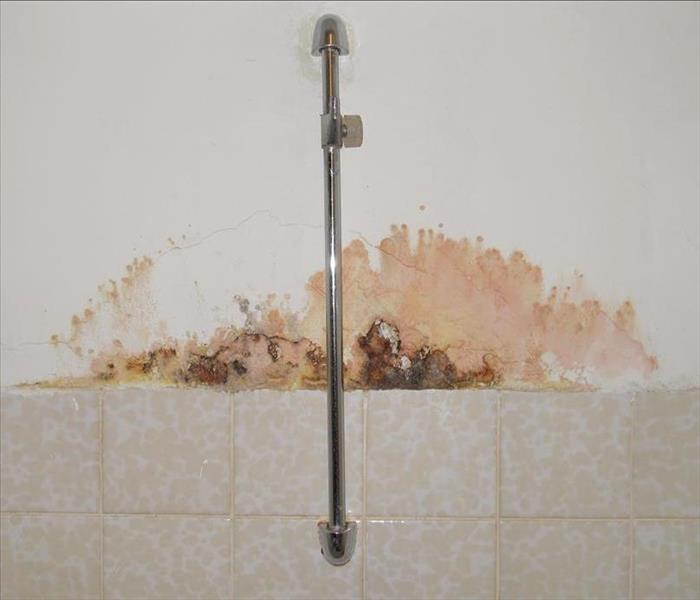 Our professionals at SERVPRO of North Fulton County can break your mold and make it look like it never even happened!
Our professionals at SERVPRO of North Fulton County can break your mold and make it look like it never even happened!
Problems with Mold
Georgia is known as a state for its peanuts, onions, as well as high humidity and plenteous rainfall. Rain and humidity is a very favorable condition for mold growth. When standing water is introduced into any environment, it gives rise to mold, generally within 48 hours. Black mold (“Stachybotrys chartarum”) is the more common species of mold which is toxic. However, it is best to treat any mold condition as dangerous.
If you experience any mold damage in Alpharetta, call us. Our SERVPRO Professionals can handle all types of mold conditions. After a fire, mold can grow due to the water used to put it out. Small leaks behind walls due to burst pipes, can happen. Sewage and plumbing problems are other events that can cause mold growth.
Our mold containment process involves our knowledge of how mold grows and hides. We do a thorough property inspection for mold and places with hidden water. Our SERVPRO experts then use various technology procedures to stop mold in its tracks. We use advanced negative air pressure procedures, specialized filtration equipment, powerful air scrubbers and HEPA vacuums.
Place your mold problems into our hands. We will clean your furniture, clothing, curtains and so much more. Our IICRC certified technicians are trained to remove the odors that emanate from the mold. If your home or business has extensive mold damage, our restoration service also involves minor and major repairs to help get you back to a pre-mold condition.
Locally Owned Company with National Resources
SERVPRO of North Fulton County is locally owned and operated. We can respond quickly when you contact us for mold emergencies. We are available with 24-hour emergency service, including holidays. No matter how small or how large your mold issue is, we can handle projects of any size. Call us at (770) 992-2777 with any questions you may have.
Professional North Fulton County Mold Remediation Experts
5/24/2016 (Permalink)
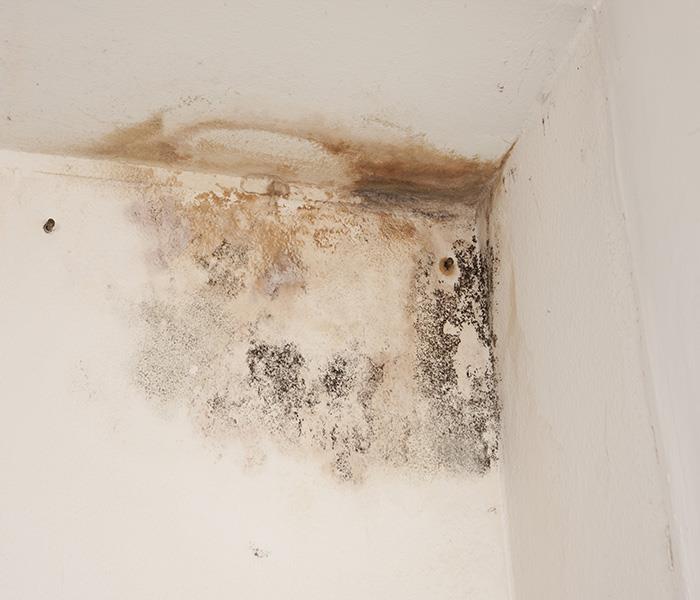 Mold damage can be detrimental to your residential and commercial property.
Mold damage can be detrimental to your residential and commercial property.
Professional Mold Remediation
As a natural existing fungus, mold belongs to a group of biological organisms, but with both harmful and positive characteristics. Alexander Fleming accidentally discovered penicillin by using mold that was growing in a petri dish. Dr. Fleming knew what mold was, which was not the miracle, but that the mold had killed the diseased germ - Staphylococcus aureus, that he had been growing in the petri dish. The result is, of course, an antibiotic like penicillin.
However, mold damage in Sandy Springs that is growing in homes and businesses is not beneficial because it is too toxic to breathe in. Is mold considered dangerous? Yes, as identified by the CDC and the EPA, but the mold removal industry is not regulated in all U.S. States. Congress and around 20 states are working together to create a state-wide mold-related legislation. Georgia is one of the non-regulated states which is why property owner's need to find reputable, trustworthy mold specialists. For this purpose, it is essential to find experienced commercial and residential mold removal professionals.
Many people believe that bleach can easily kill mold, but this is a myth. The hyphae, or root structure, allows mold to attach and grow on surfaces. Bleach can remove the surface mold, but it can not penetrate into porous materials, like drywall and wood. When people spray the porous surface mold with bleach, the water part of the bleach soaks into the surface, which can foster further mold growth, while the bleach element sits on top of the surface, turns to gas and begins to evaporate, which only partially kills the surface layer of mold.
Georgia's climate can also affect how mold grows. Mold spores can reproduce in wet or damp part of a home and in areas where there is flooding or where leaks occur in rooftops, pipes, walls, clothing and even house plants especially if they have been over- watered. Mold can grow from spores 48-72 hours after conducive conditions are met, meaning moisture, food source, and temperature between 45 and 100 degrees. Sandy Springs mold damage in a home or business not only threatens the health of its occupants, but it will also decrease the value of your property.
All of these factors contribute to the growth of mold, which is why only licensed professionals should be used to rid your home or office from its colonization and contamination. The first step in mold remediation is to remove it to prevent human exposure and to limit further damage to building materials and furnishings. All infected materials must be discarded because mold can infiltrate porous surfaces and continue to grow on or to fill in empty spaces and crevices.
As your SERVPRO of North Fulton County mold remediation experts, we are ready 24/7 with quality emergency services. Our staff is trained in property damage restoration, no matter how big or small your structure is, we've got you covered! We are locally owned and operated, which means that we live and work in this community. We are proud to help our local communities, like Alpharetta, Johns Creek, and Roswell. If a catastrophic storm or event occurs, call us immediately at (770) 992-2777.
The Most Common Places for Mold in Your Milton Home
6/19/2015 (Permalink)
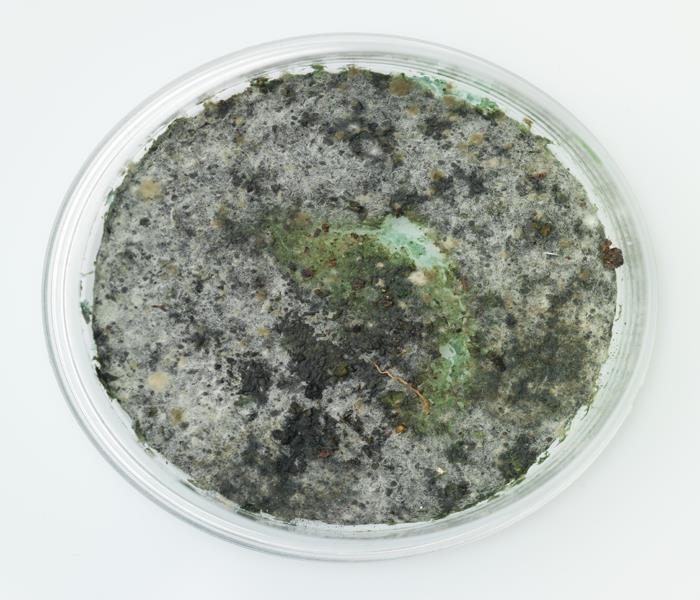 Mold grows from constant moisture buildup from damp surfaces, water leaks, and humid climates.
Mold grows from constant moisture buildup from damp surfaces, water leaks, and humid climates.
The Most Common Places for Mold in the Home
For as long as people have been living indoors, Milton mold has been a serious issue to conquer. No dwelling is immune to the spread of mold. Mold grows from constant moisture buildup from damp surfaces, water leaks, and humid climates.
The problem with Milton mold is it can spread if it is not treated immediately. You may find a little mold in the corner of a wall and it will quickly spread to the floor, all over the wall, on your furniture, and even up to the ceiling. There is really no place that mold cannot spread. To keep from developing a mold infestation, perform regular checks where mold typically grows like the basement and other areas of the home that tend to stay damp.
Basements
The basement can be a breeding ground for mold. It has a tendency to be damp due to the drainage of water that flows through it. Basements are filled with pipes, sinks, sump pumps, and other fixtures that can potentially develop a water leak, overflow or a simple collection of water, which will in turn create the perfect scenario for mold to grow. Spores can grow from any type of moisture in the ground and spread to your walls. Home basements with concrete walls tend to be covered with drywall and drywall can be a perfect environment for mold spores to grow, since it is made from wood.
Bathrooms
Bathrooms are another important space to check regularly for mold. Bathrooms are filled with pipes, drains, porous surfaces and fixtures that use water on a daily basis. Bathrooms are the one room in the house that stays damp more than it stays dry. Every shower and bath taken in a bathroom can create a moist, damp, and humid room for mold to grow. Your bathroom is the last room you want mold growing and destroying your space. Tile is used in bathrooms to keep mold at bay, however, drywall is still used under the tile making it a hot bed for mold growth.
Kitchens
The kitchen, though not as bad as bathrooms, can still develop a mold situation. The sink area is the main area to keep a focused eye on because drains and pipes could have leaks, not to mention the water left behind from washing dishes and preparing food. Keep in mind, though you may only have one water source in your kitchen, spills and standing water can also cause mold.
Milton mold can be a costly condition in your home. Performing regular checks and cleaning the traditional areas with a cleaning agent designed to kill mold and prevent its re-occurrence can help you keep your home mold free. If your mold problem gets worse contact SERVPRO of North Fulton County to help.
Understanding Mold
Confusion and misunderstanding surround the topic of mold and mold remediation. Some restoration businesses even make claims to remove all mold from a building. This is a fallacy. Mold spores occur naturally almost everywhere, both indoors and outdoors. These microscopic spores float along in the air and can enter a home or business through windows and HVAC systems. Consider these facts:
- Mold is present almost everywhere, indoors and outdoors.
- Mold spores are microscopic and float along in the air and may enter your home through windows, doors, or AC/heating systems or even hitch a ride indoors on your clothing or a pet.
- Mold spores thrive on moisture. Mold spores can quickly grow into colonies when exposed to water. These colonies may produce allergens and irritants.
- Before mold remediation can begin, any sources of water or moisture must be addressed. Otherwise, the mold may return.
- Mold often produces a strong, musty odor and can lead you to possible mold problem areas.
- Even higher-than-normal indoor humidity can support mold growth. Keep indoor humidity below 45 percent.
 Mold comes from water damage and water damage can come from anywhere, including as simple as a rainy day.
Mold comes from water damage and water damage can come from anywhere, including as simple as a rainy day.





 24/7 Emergency Service
24/7 Emergency Service
